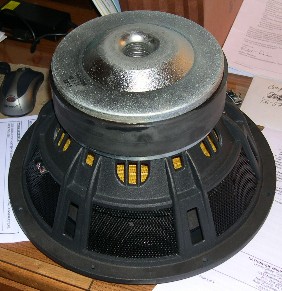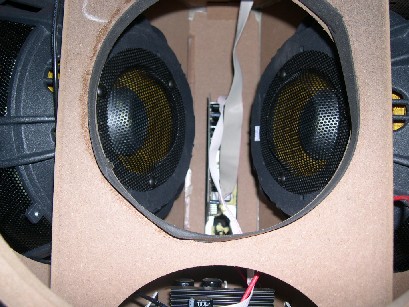Secrets Benchmark Product Review Klipsch RT-12d Subwoofer Part I December, 2006 Ed Mullen
|
Introduction
Founded in 1946, Klipsch Audio Technologies (Klipsch) has
become one of the leading manufacturers of speakers for audio and home
theater use, and is a popular choice with audiophiles and home theater
aficionados around the world.
Since the year 2000, Klipsch has introduced more new products than at any
other time in its 60 year history. Klipsch manufactures floorstanding,
bookshelf, and architectural speakers, powered subwoofers, center
channels, and surround sound speakers.
The RT-12d is one of their latest, and largest
subwoofers.
General Product Description
The RT-12d packaging solution was well-engineered and protective of the subwoofer.
Additional items in the shipping container included a plug-in microphone
(for the auto-EQ feature), a detachable power cord, and the Owner's Manual
with serial number label.
The Owner's Manual is presented in no less than seven languages, and is
well-written, comprehensive, and detailed, with excellent photographs and
diagrams explaining proper control usage and all aspects of operation.
Corner placement is easy with the triangular shaped cabinet. Dimensions are
roughly 19" H x 24" W x 22" D, and the subwoofer weighs about 71 pounds.
Floor interface is handled by heavy-duty rubber feet. The amp co nnections
are in the rear, while the amplifier itself is internally mounted on the
cabinet bottom. The digital interface control panel is top-mounted for easy
user access. The cabinet interior features one brace with a cut-out for the
woofer magnet.
nnections
are in the rear, while the amplifier itself is internally mounted on the
cabinet bottom. The digital interface control panel is top-mounted for easy
user access. The cabinet interior features one brace with a cut-out for the
woofer magnet.
The three grilles feature an injection-mold plastic lattice framework that
can withstand a collision with a running dog or child; owners with active
households will appreciate this. The grille grommets are rubber allowing
them to damp vibration and flex if someone accidentally leans on the grille
tops while connecting or adjusting the subwoofer.
The RT-12d is available in two finishes – cherry or black ash wood veneer.
The review model came finished in black ash. Fit and finish on the review
model were great, with no surface flaws and tight seams and tolerances.
Woofer and Passive Radiator Description
This subwoofer is a bass reflex alignment, with a 12" front-firing active
driver, and dual side-firing 12" passive radiators. The woofer is an
overhung voice coil design, with dual spiders featuring woven opposing
tinsel leads, a double stacked magnet with vented pole piece, a cast basket
frame, and that famous copper-colored Cerametallic™ cone with a
high-excursion rubber surround. The passive radiators use similar cones,
surround, spider, and cast basket components. The woofer is attached to the
cabinet with machine screws and recessed nuts – a nice touch.
|
|
|
Digital Control Panel and Amplifier Description
The top-mounted digital control panel is so convenient it makes you wonder
why other manufacturers didn't include this feature long ago. The keypad
features up/down push buttons to scroll through the menu, and left/right
push buttons for adjusting each setting. There is a center push button to
store and recall settings or to lock the keypad.
Digital Control Panel Features:
Volume
Memory Presets (Music, Movies, Night, User1, User2)
EQ Mode (Flat, Depth, Punch)
Room Correction (auto-EQ)
Low-Pass Filter Frequency (40-120 Hz)
Low-Pass Filter Slope (18, 24, 36, 48 dB/octave)
Low-Pass Filter Bypass (LFE Mode)
Phase (0-180 degrees variable)
Panel Brightness (4 intensity settings)
Power (auto-on with standby or always-on)
Demo (two 12-second demos)
Keypad Lock
System Info Settings
While I certainly applaud the flexibility of the adjustable frequency and
slope of the Low-Pass filter, most owners will probably use the digital bass
management circuit (which imposes a Low-Pass filter on the subwoofer) in the
surround sound processor (SSP). The "Lowpass Off - LFE Mode" setting on the
RT-12d is appropriate in this case.
The Depth EQ setting boosts the 30 Hz region, and the Punch setting
boosts the 55 Hz region. As one might suspect, the Flat setting uses no EQ.
Refer to the In-Room Frequency Response section of this review for FR charts
showing each EQ Mode settings. My goal for subwoofer reviews is to always
obtain a flat frequency response at the listening position so I didn't use
the Depth and Punch settings, but they might appeal to some listeners
looking to add a little flavor to the bass mix. Regardless, I would
recommend the Flat setting prior to engaging the auto-EQ Room Correction
routine.
The Auto-EQ Room Correction (Called Adaptive Room Correction or ARC by
Klipsch) utilizes a microphone (placed at the listening
position) and generates a sine sweep from 15-120 Hz over about 55 seconds.
The software attempts to smooth the frequency response by attenuating peaks
in the response using a parametric equalizer. I tried the Auto-EQ at
several different subwoofer locations and listening positions, and found it
an accurate and useful feature. I deliberately introduced room nulls at
certain sub/mic locations in an attempt to trip up the software, and it
consistently ignored true nulls rather than vainly trying to boost them -
thus passing this test with flying colors. Refer to the In-Room Frequency
Response section of this review for a before/after FR chart showing the
operation of the Room Correction routine.
Amplifier Features:
Digital BASH (800 watts continuous)
Clipping, Thermal, and Overload Protection
Detachable Power Cord
Power Switch (rocker)
IR Sensor (for remote control – codes available at the Klipsch website)
USB Port (PC interface for advanced users)
Mic Input (for auto-EQ feature)
Low Level L/R RCA inputs
Low Level L/R RCA outputs (unfiltered)
During subwoofer break-in with sine waves, I noticed a small air leak from
the USB port. I could not detect this air leak during normal music/movie
listening sessions, nor do I believe it negatively affected the performance
of the subwoofer. The USB port allows more advanced users to access
additional menu options in the Room Correction software. Proprietary Klipsch
software is required for your PC in order to use this capability. Included
below is a screen shot of the software showing the PEQ parameters used to
modify the frequency response shown. Contact Klipsch Technical Support for
more details if you are interested in using this advanced PC software.

|
© Copyright 2006 Secrets of Home Theater & High Fidelity |






